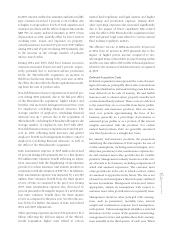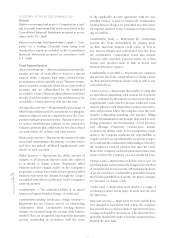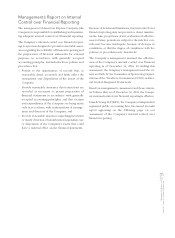American Express 2004 Annual Report Download - page 70
Download and view the complete annual report
Please find page 70 of the 2004 American Express annual report below. You can navigate through the pages in the report by either clicking on the pages listed below, or by using the keyword search tool below to find specific information within the annual report.
GLOSSARY OF SELECTED TERMINOLOGY
General
Return on average total assets — Computed on a trail-
ing 12-month basis using total assets as included in the
Consolidated Financial Statements prepared in accor-
dance with U.S. GAAP.
Return on average total shareholders’ equity — Com-
puted on a trailing 12-month basis using total
shareholders’ equity as included in the Consolidated
Financial Statements prepared in accordance with
U.S. GAAP.
Travel Related Services
Asset securitizations — Asset securitization involves the
transfer and sale of receivables or loans to a special
purpose entity, a separate legal entity, created for the
securitization activity, typically a trust. The trust, in turn,
issues securities, commonly referred to as asset-backed
securities that are collateralized by the transferred
receivables or loans. The trust utilizes the proceeds from
the sale of such securities to pay the purchase price for
receivables or loans that were sold into the trust.
Average discount rate — Represents the percentage of
billed business that is paid by a merchant accepting the
American Express card as compensation for the Com-
pany providing its payment service. Discount rates vary
by service establishment, industry sector, transaction
volumes, payment plan, risk levels for loss due to fraud
or credit within the industry and other factors.
Basic cards-in-force — Represents the number of cards
issued and outstanding to the primary account owners
and does not include additional supplemental cards
issued on such accounts.
Billed business — Represents the dollar amount of
charges on all American Express cards; also referred
to as spend or charge volume. Proprietary billed
business includes charges made on the Company’s
proprietary cards-in-force while non-proprietary billed
business represents the charges through the Compa-
ny’s global network on cards issued by the Company’s
network partners.
Cardmember — The individual holder of an issued
American Express branded charge or credit card.
Cardmember lending net finance charge revenue —
Represents the net revenue earned on outstanding
cardmember loans. Cardmember lending finance
charges are assessed using the average daily balance
method. They are recognized based upon the principal
amount outstanding in accordance with the terms
of the applicable account agreement until the out-
standing balance is paid or written-off. Cardmember
lending finance charges are presented net of the inter-
est expense incurred by the Company to finance lend-
ing receivables.
Cardmember loans — Represents the outstanding
amount due from cardmembers for charges made
on their American Express credit cards, as well as
any interest charges and card-related fees due from
the cardmember. Cardmember loans also include
balances with extended payment terms on certain
charge card products such as Sign & Travel and
Extended Payment Option.
Cardmember receivables — Represents the outstand-
ing amount due from cardmembers for charges made
on their American Express charge cards as well as any
card-related fees.
Cards-in-force — Represents the number of cards that
are issued and outstanding. Total cards-in-force includes
basic cards issued to the primary account owner and any
supplemental cards which represent additional cards
issued on that account. Proprietary cards-in-force repre-
sent card products where the Company owns the card-
member relationship including card issuance, billing
and credit management and strategic plans such as mar-
keting, promotion and development of card products
and offerings. Proprietary cards-in-force include
co-brand and affinity cards. For non-proprietary cards-
in-force, the Company maintains the responsibility to
acquire and service merchants that accept the Compa-
ny’s cards and the cardmember relationship is owned by
the Company’s network partners that issue the cards.
Most of the Company’s network partners provide cards-
in-force data to the Company on a one-month lag basis.
Charge cards — Represents cards that carry no pre-set
spending limits and are primarily designed as a method
of payment and not as a means of financing purchases
of goods or services. Cardmembers generally must pay
the full amount billed each month. No finance charges
are assessed on charge cards.
Credit cards — Represents cards that have a range of
revolving payment terms, grace periods and rate and
fee structures.
Discount revenue — Represents revenue earned from
fees charged to merchants with whom the company
has entered into a card acceptance agreement for pro-
cessing cardmember transactions. The discount fee is
generally deducted from the Company’s payment reim-
bursing the merchant.
AXP
AR.04
68
Financial Review
























